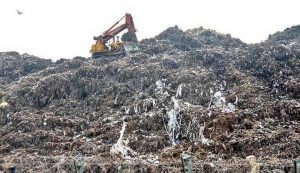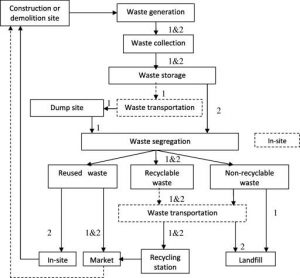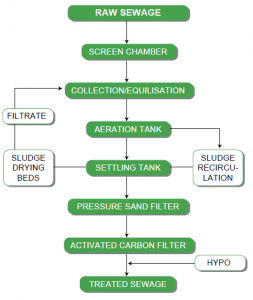Households, industries and agricultural fields discard a wide variety of solid waste. This includes plastics, metals, electronics, crop residue, biomedical and construction waste. Collection, treatment, and the safe disposal of this waste is termed as Solid Waste Management (SWM), which is imperative for an environmentally sustainable economy. Ineffective waste disposal leads to health hazards, environmental pollution, and fatal working conditions for cleaners and manual scavengers.
The 74th Amendment to the Indian Constitution lists SWM under the Twelfth Schedule. This means that the responsibility lies with urban local bodies. SWM in most Indian cities is characterised by enormous landfills, open dumps, non-segregation at source and poor recycling capabilities. Municipal laws do not adequately address the problem of effective waste disposal. Rapid urbanisation is expected to further aggravate this problem. Figure 1 below illustrates the nature and scale of the challenge in India.
Along with local bodies, a crucial role is to be played by the local community. Waste management has a direct bearing on people’s lives. Community participation is especially necessary for waste segregation and recycling.

Figure 1 : Bandhwari landfill site in Haryana; Source: The Hindu – Photo by Manoj Kumar (Kumar, 2016)
Waste-Ful(l) Haryana!
Haryana generates 4,265 tonnes of solid waste every day; this number is projected to grow to 7,675 tonnes by 2035 (Government of Haryana, 2017). To put it in perspective, this is comparable to the weight of 170 Boeing aircrafts! Furthermore, door-to-door solid waste collection occurs in only 318 out of 1,473 municipal wards (ibid.). In rural areas, an overwhelming 96% residents reported that no garbage collection facilities exist (Institute for Development and Communication, 2014).
In recent years, there have been rapid developments in solid waste management technology. These technologies improve waste collection efficiency and help in extracting value from waste. These technologies, and the best practices emanating from them, will be the focus of this article.
In this note, we begin by examining Haryana government’s efforts at implementing SWM technologies. This is followed by a review of some cost-effective technologies that have improved waste collection and disposal efficiency in India and abroad. This article will then describe success stories in SWM technologies that have brought positive and sustainable change to communities.
Government Efforts towards SWM in Haryana
This section describes existing government efforts that have either been planned or implemented in Haryana.
- Cluster-Based Approach: At the heart of Haryana’s SWM policy is the Cluster-Based Approach; 15 SWM clusters are planned in urban and rural areas. Out of these three clusters – in Gurugram, Faridabad, and Sonipat – will incorporate waste-to-energy models and the remaining 12 will employ compost-based models (The Pioneer, 2018).
- Integrated SWM Projects: According to reports, technology-intensive SWM projects are being set up in Gurugram and Faridabad. The project includes a modern compost processing unit, biogas, and a radio direction finder. E-rickshaws have been used for door-to-door collection (NDTV, 2017).
- Other SWM Projects: Similarly, 20 SWM projects are planned in Yamunanagar, Kurukshetra and Kaithal districts (Times of India, 2018). Sewage treatment plants are also planned in Bahadurgarh, Charkhi Dadri, Karnal, Yamunanagar, Ambala, Narnaula, and Rohtak. 85 units have been registered for recycling and reprocessing of hazardous waste (Government of Haryana, 2017).
Thus, the state government has launched several major SWM projects. However, what is lacking on the ground is the use of simple technologies that could drastically improve waste collection efficiency. Development of such simple technologies will help derive more value from waste.
Technological Interventions in SWM
In view of various problems faced in the disposal of solid waste, some technological interventions used in different parts of the world are discussed below. These technologies have helped improve efficiency in SWM. For reference, various stages of the SWM for a construction site is depicted in Figure 2 (Aly, 2014).
Optical and sensor-based sorting (waste segregation stage): Proper segregation and sorting is the bedrock of effective SWM. Poor segregation prevents proper recycling and effective functioning of bio-methanation plants. It also causes waste-to-energy plants to release toxic pollutants into the atmosphere (Ahluwalia & Patel, 2018). Sorting technology has made significant progress in recent years. Optical sorting helps segregate plastics, composites and other waste using colour sensitive cameras, ultraviolet sensors, and infrared spectroscopy. Similarly, Mechanical Biological Treatment (MBT) is focused on energy recovery from waste. Biological processes aim to minimise water content while mechanical processes separate metals and glass from waste (Saleem, Zulfiqar, Tahir, Asif, & Yaqub, 2016).

Figure 2: Construction and demolition waste management life cycle (Source: Housing and Building National Research Journal; Author – Manal Aly (Aly, 2014))
Geographical Information System (GIS) Technology (waste transportation stage): Waste collection in India is largely an informal process. This provides room for irregularities, frauds, and corruption. There is no tracking of relevant stakeholders. Data on waste collection is also lacking. Geographic Information System (GIS) technology is useful in this regard. For instance, GIS-based waste collection in Italy has allowed full traceability and certification of the entire waste cycle. It has allowed optimization of the complete process including collection routes. According to Italian case studies, GIS technology has increased waste collection efficiency by 80% as pointed by Saleem et. al (2016).
Garbage compactors (waste collection stage): The rapidly increasing volume of waste has led to an increase in transportation costs. A remedy to this is to fit garbage compactors in collection trucks. Such trucks reduce the volume of waste and improve fuel efficiency. These are capable of carrying 1.5 times more waste as compared to normal trucks, according to Saleem et. al (2016).
Underground Collection System (dump site): Open dumps and tanks contribute to environmental and public health hazards. They allow for the breeding of diseases and the release of unpleasant odours, resulting in the contamination of soil and groundwater. In this regard, local bodies must switch to underground collection systems excavated at a 2-3m depth with only the inlet exposed. Garbage in an underground system is more likely to be decomposed by soil bacteria besides being maintenance-free and also aesthetically acceptable.
Several local bodies in the country have used such scientific measures to improve SWM. These initiatives have helped in reducing health hazards and environmental pollution besides deriving value from waste.
Best Practices in SWM
In this section, certain best practices in SWM from across the country and international examples are reviewed. A suitable version of these practices can be accommodated in Haryana for better waste management.
- Scientific closure of Gorai landfill site (Mumbai): Gorai was a 19-hectare sprawling landfill site with garbage piles measuring 26m in length (Sustainable Sanitation Alliance, 2018). The dump had become a major environmental hazard with an unbearable stench reported by the local population. In 2007, the Brihan Mumbai Municipal Corporation (BMC) decided to close the landfill site. The scientific closure of Gorai landfill site is the first of its kind in India and considered a great success story in SWM (ibid.) Various technological interventions were used for the process as highlighted by Sustainable Sanitation Alliance (2018):
-
- Nearly 3.24 million tonnes of garbage was compressed and then capped in three layers of geosynthetic lining at varying depths;
- Sheet piles were installed to control ingress and inundation of tidal water and leachate escape into surrounding area;
- Leachate gas collection system was established from where the gas could be collected in wells for flaring;
- Landfill gas recovery system was installed at the site;
The hazardous landfill site has been converted into a landscaped green area and the quality of life of the people of Gorai has significantly improved (ibid).
- Vermicomposting in Vijayawada: On realising that 70% of the city’s waste is organic, the Vijayawada Municipal Corporation (VMC) set up vermicomposting units in the city. Vermicomposting is the breakdown of organic matter using earthworms. The vermicomposting process takes place in 30-45 days after which the earthworms excrete dark, odourless, nutrient and organically rich mud granules called soil castings that make an excellent soil conditioner. The intervention has helped reduce the volume of garbage in the city besides producing a cheap source of manure (Sustainable Sanitation Alliance, 2018)
- Off-grid sewage treatment in Avadi (Chennai): Lack of sewage treatment facilities in Avadi had led to stagnation of water, foul odour leading to waterborne diseases. The Tamil Nadu Police Housing Corporation (TNHPC) decided to construct an off-grid sewage treatment plant (STP) in the locality. Activated sludge control (Figure 3) was used due to its simplicity and reliability. The method uses air and a biological floc composed of bacteria and protozoa to treat sewage because of which the STP has been a great success. It treats 12 lakh litres of sewage every day with no negative discharge, produces manure, recharges groundwater, removes the source of the foul odour, incidence of waterborne diseases, and beautifies the area (NITI Aayog, 2015).

Figure 3: Activated sludge control for sewage treatment (Source: Good Practices Resource Book 2015, NITI Aayog Knowledge Hub (NITI Aayog, 2015)
- Waste-to-energy in Sweden: Sweden has taken great strides in the conversion of waste to energy. 50% of household waste is burnt to produce energy (Freden, 2017), and has in fact become a net importer of waste. In 2014, Sweden imported 2.7 million tonnes of waste from other countries that were converted into energy. Plasma gasification technology has been used in the country which allows the clean destruction of hazardous wastes (Stringfellow, 2014). In this process, solid waste is converted into syngas which can be used to provide both thermal and electric energy.
- Urine-based fertilisers in Nepal: In Siddhipur (Nepal), urine has been utilised to manufacture Struvite – a dry fertiliser product that can be used in agricultural fields (Sustainable Sanitation Alliance, 2018). Urine is separated from solid wastes at the household level. To the collected urine, magnesium is added to precipitate Struvite. This is a necessary intervention for the Nepalese as the country imports all its fertilisers. This eco-friendly technology has helped improve sanitation and local food security in Siddhipur (ibid.)
- Segregation in Tanzania: The Centre for Science and Environment, India, has adopted a Decentralised Waste Management approach in Zanzibar, Tanzania, in which majority waste is recycled, and only 5-10% is sent to engineered landfills (Centre for Science and Environment, 2018). This framework provides a community-driven process of sustainable waste handling. This has helped residents produce more than 500kg of compost and earn substantially from the sale of fruits and vegetables (ibid.)
Moving Forward with Technology
The sheer volume of solid waste that is generated in Haryana calls for urgent attention and proactive measures to scientifically manage waste. One suggestion is to learn from the Gorai model as the saturated landfill sites at Bandhwari and Panchkula may be scientifically closed. Secondly, vermicomposting units must be set up in rural Haryana as it will provide organic fertilisers necessary for improving soil health.
Simple technologies such as garbage compactors, GIS, and underground collection systems may be used by local bodies to increase efficiency in waste collection. The state government could also invest in the research of optical and sensor-based sorting technologies to pioneer their introduction in the country.
References
Ahluwalia, I. J., & Patel, U. (2018, April). Solid Waste Management in India: An assessment of resource recovery and environmental impact. ICRIER, p. 1.
Aly, M. (2014). Assessment of different construction and demolition waste management approaches. Research Gate.
Center for Science and Environment. (2018). Model Framework for Segregation: Guidelines for managing municipal solid waste through segregation, reuse and recyclingin Zanzibar. Center for Science and Environment.
Freden, J. (2017, March 29). Nature: The Swedish Recycling Revolution. Retrieved from Sweden: Click Here
Government of Haryana. (2017). Government of Haryana Vision 2030. Government of Haryana.
Institute for Development and Communication. (2014). Basic Public Services in Haryana State: Processes, Procedures and Delivery Mechanisms. Department of Planning, Government of Haryana.
Jain, D. A., & Dibya, D. K. (2016, July). Harmful effects of e-waste on living beings and environment. Drilling and Exploration World, pp. 82-87.
Kumar, M. (2016, November 7). Gurgaon. Retrieved from The Hindu: Click Here
NDTV. (2017, August 17). Swachh India. Retrieved from NDTV: Click Here
NITI Aayog. (2015). Avadi Sewage Treatment Plant: Sustainable off-grid sewage treatment in Chennai. Social Sector Service Delivery: Good Practices Resource Book 2015, 53-57.
Saleem, W., Zulfiqar, A., Tahir, M., Asif, F., & Yaqub, G. (2016). Latest technologies of municipal solid waste management in developed and developing countries: A review. International Journal of Advanced Science and Research, 22-29.
Stringfellow, T. (2014, January 13). An Independent Engineering Evaluation of Waste-to-Energy Technologies. Retrieved from Renewable energy world: https://www.renewableenergyworld.com/articles/2014/01/an-independent-engineering-evaluation-of-waste-to-energy-technologies.html
Sustainable Sanitation Alliance. (2018). Knowledge Hub: Resources and Publications. Retrieved from Susana: Click Here
The Pioneer. (2018, March 19). State Edition – Chandigarh. Retrieved from Daily Pioneer: Click Here
Times of India. (2018, April 5). City – Chandigarh. Retrieved from Times of India: Click Here

